check engine CADILLAC DEVILLE 1998 7.G Repair Manual
[x] Cancel search | Manufacturer: CADILLAC, Model Year: 1998, Model line: DEVILLE, Model: CADILLAC DEVILLE 1998 7.GPages: 386, PDF Size: 22.36 MB
Page 307 of 386
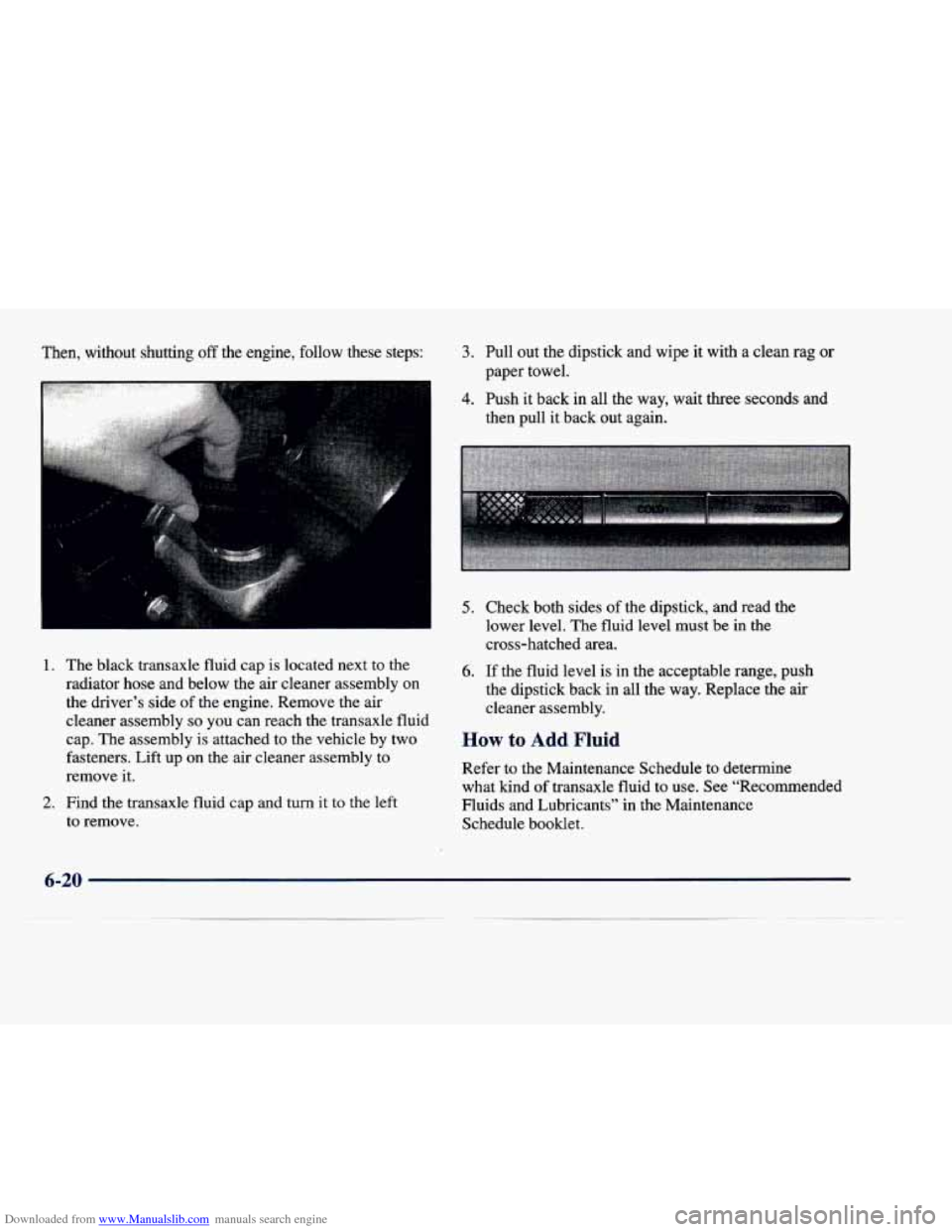
Downloaded from www.Manualslib.com manuals search engine Then, without shutting off the engine, follow these steps:
I
1. The black transaxle fluid cap is located next to the
radiator hose and below the air cleaner assembly on
the driver’s side of the engine. Remove the air
cleaner assembly
so you can reach the transaxle fluid
cap. The assembly
is attached to the vehicle by two
fasteners. Lift up on the air cleaner assembly to
remove it.
2. Find the transaxle fluid cap and turn it to the left
to remove.
3. Pull out the dipstick and wipe it with a clean rag or
4. Push it back in all the way, wait three seconds and
paper towel.
then pull it back out again.
5. Check both sides of the dipstick, and read the
lower level. The fluid level must be in the
cross-hatched area.
6. If the fluid level is in the acceptable range, push
the dipstick back in all the way. Replace the
air
cleaner assembly.
How to Add Fluid
Refer to the Maintenance Schedule to determine
what kind of transaxle fluid to use. See “Recommended
Fluids and Lubricants” in the Maintenance
Schedule booklet.
6-20
Page 308 of 386
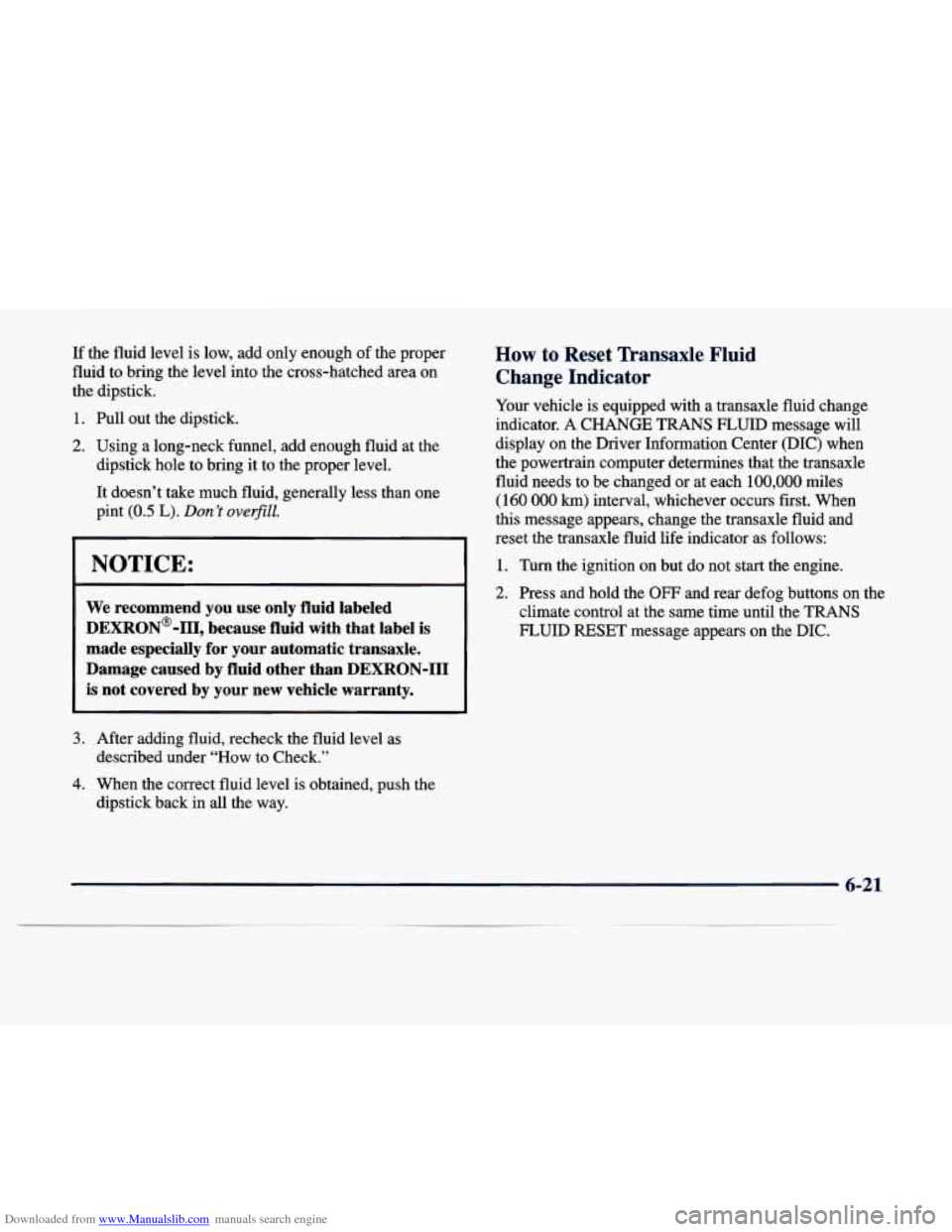
Downloaded from www.Manualslib.com manuals search engine If the fluid level is low, add only enough of the proper
fluid to bring the level into the cross-hatched area on
the dipstick.
1. Pull out the dipstick.
2. Using a long-neck funnel, add enough fluid at the
dipstick hole to bring it to the proper level.
It doesn’t take much fluid, generally less than one
pint
(0.5 L). Don’t overfill.
NOTICE:
We recommend you use only fluid labeled
DEXRON@-111, because fluid with that label is
made especially for your automatic transaxle.
Damage caused by fluid other than DEXRON-111
is not covered by your new vehicle warranty.
How to Reset Transaxle Fluid
Change Indicator
Your vehicle is equipped with a transaxle fluid change
indicator.
A CHANGE TRANS FLUID message will
display on the Driver Information Center (DIC) when
the powertrain computer determines that the transaxle
fluid needs to be changed
or at each 100,000 miles
(160 000 km) interval, whichever occurs first. When
this message appears, change the transaxle fluid and
reset the transaxle fluid life indicator as follows:
1. Turn the ignition on but do not start the engine.
2. Press and hold the OW and rear defog buttons on the
climate control at the same time until the TRANS
FLUID
RESET message appears on the DIC.
3. After adding fluid, recheck the fluid level as
described under “How to Check.”
4. When the correct fluid level is obtained, push the
dipstick back in all the way.
6-21
Page 310 of 386

Downloaded from www.Manualslib.com manuals search engine What to Use
Use a mixture of one-half clean water (preferably
distilled) and one-half
DEX-COOL@ coolant which
won’t damage aluminum
parts. If you use this mixture,
you don’t need to add anything else.
I
Adding only plain water to your cooling system
can be dangerous. Plain water, or some other
liquid like alcohol, can boil before the proper
coolant mixture will. Your vehicle’s coolant
warning system
is set for the proper coolant
mixture. With plain water or the wrong mixture,
your engine could get too hot but you wouldn’t
get the overheat warning. Your engine could
catch fire and you or others could be burned.
Use a
50/50 mixture of clean water and
DEX-COOL@ coolant.
NOTICE:
If you use an improper coolant mixture, your
engine could overheat and be badly damaged.
The repair cost wouldn’t be covered by your
warranty.
Too much water in the mixture can
freeze and crack the engine, radiator, heater core
and other parts.
If you have to add coolant more than four times a year,
have your dealer check your cooling system.
NOTICE:
If you use the proper coolant, you don’t have to
add extra inhibitors or additives which claim to
improve the system. These can be harmful.
6-23
Page 311 of 386
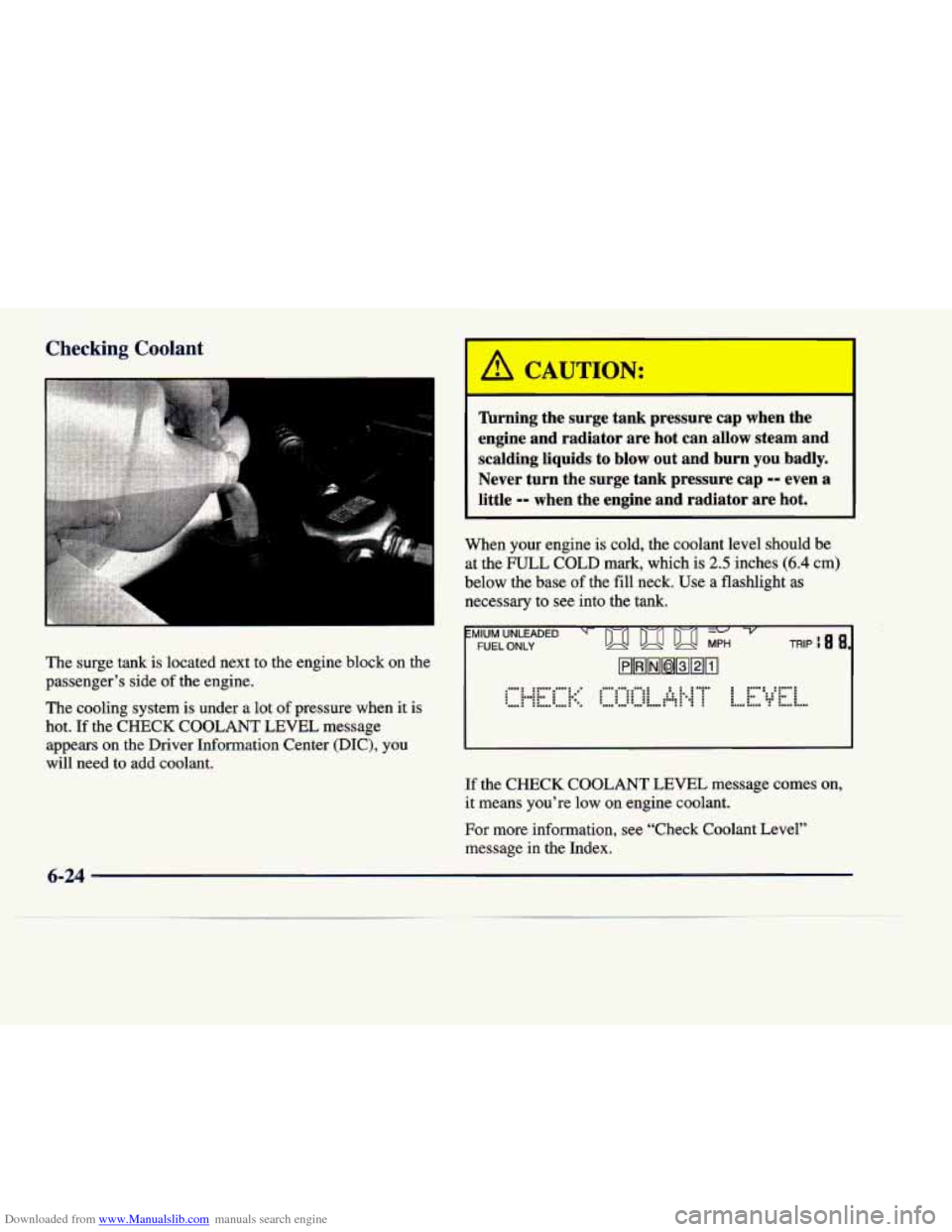
Downloaded from www.Manualslib.com manuals search engine Checking Coolant
L
The surge tank is located next to the engine block on the
passenger's side of the engine.
The cooling system is under a lot of pressure when it is
hot.
If the CHECK COOLANT LEVEL message
appears on the Driver Information Center (DIC), you
will need to add coolant.
l'brning the surge tank pressure cap when the
engine and radiator are hot can allow steam and
scalding liquids to blow
out and burn you badly.
Never turn
the surge tank pressure cap -- even a
little
-- when the engine and radiator are hot.
When your engine is cold, the coolant level should be
at the
FULL COLD mark, which is 2.5 inches (6.4 cm)
below the base
of the fill neck. Use a flashlight as
necessary to
see into the tank.
~MIUM UNLEADED -
-
FUEL ONLY IJIJ DJ DJ MK
HHrnrnrnrn
If the CHECK COOLANT LEVEL message comes on,
it means you're low on engine coolant.
For more information, see "Check Coolant Level"
message in the Index.
Page 313 of 386
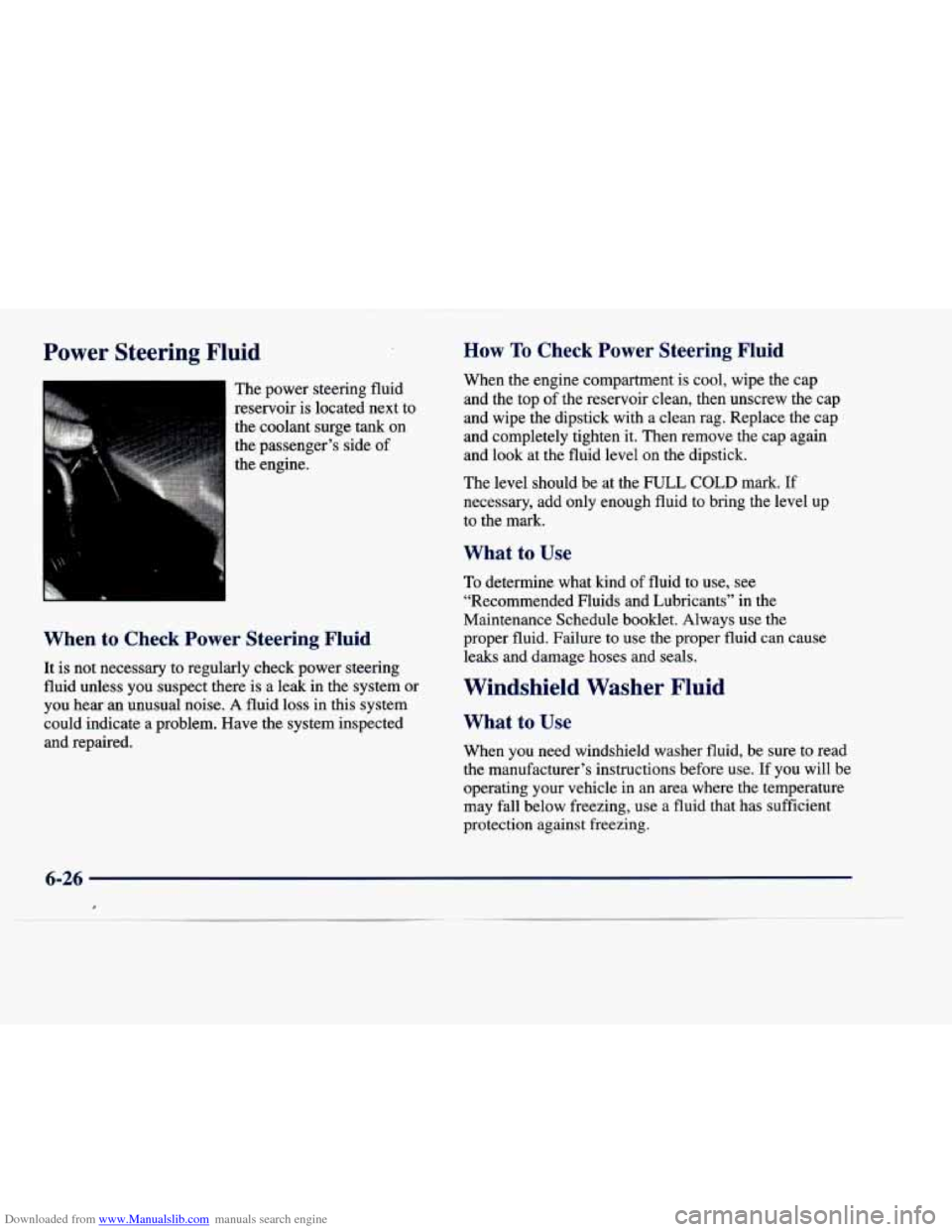
Downloaded from www.Manualslib.com manuals search engine Power Steering Fluid
The power steering fluid
reservoir is located next to
the coolant surge.tank on
the passenger’s side of
the engine.
When to Check Power Steering Fluid
It is not necessary to regularly check power steering
fluid unless you suspect there is a leak in the system or
you hear an unusual noise. A fluid loss in this system
could indicate a problem. Have the system inspected
and repaired.
How To Check Power Steering Fluid
When the engine compartment is cool, wipe the cap
and the top
of the reservoir clean, then unscrew the cap
and wipe the dipstick with a clean rag. Replace the cap
and completely tighten it. Then remove the cap again
and look at the fluid level on the dipstick.
The level should be at the
FULL COLD mark. If
necessary, add only enough fluid to bring the level up
to the mark.
What to Use
To determine what kind of fluid to use, see
“Recommended Fluids and Lubricants” in the
Maintenance Schedule booklet. Always use the
proper fluid. Failure to use the proper fluid can cause
leaks and damage hoses and seals.
Windshield Washer Fluid
What to Use
When you need windshield washer fluid, be sure to read
the manufacturer’s instructions before use.
If you will be
operating your vehicle in an area where the temperature
may fall below freezing, use a fluid that has sufficient
protection against freezing.
6-26
I
Page 325 of 386
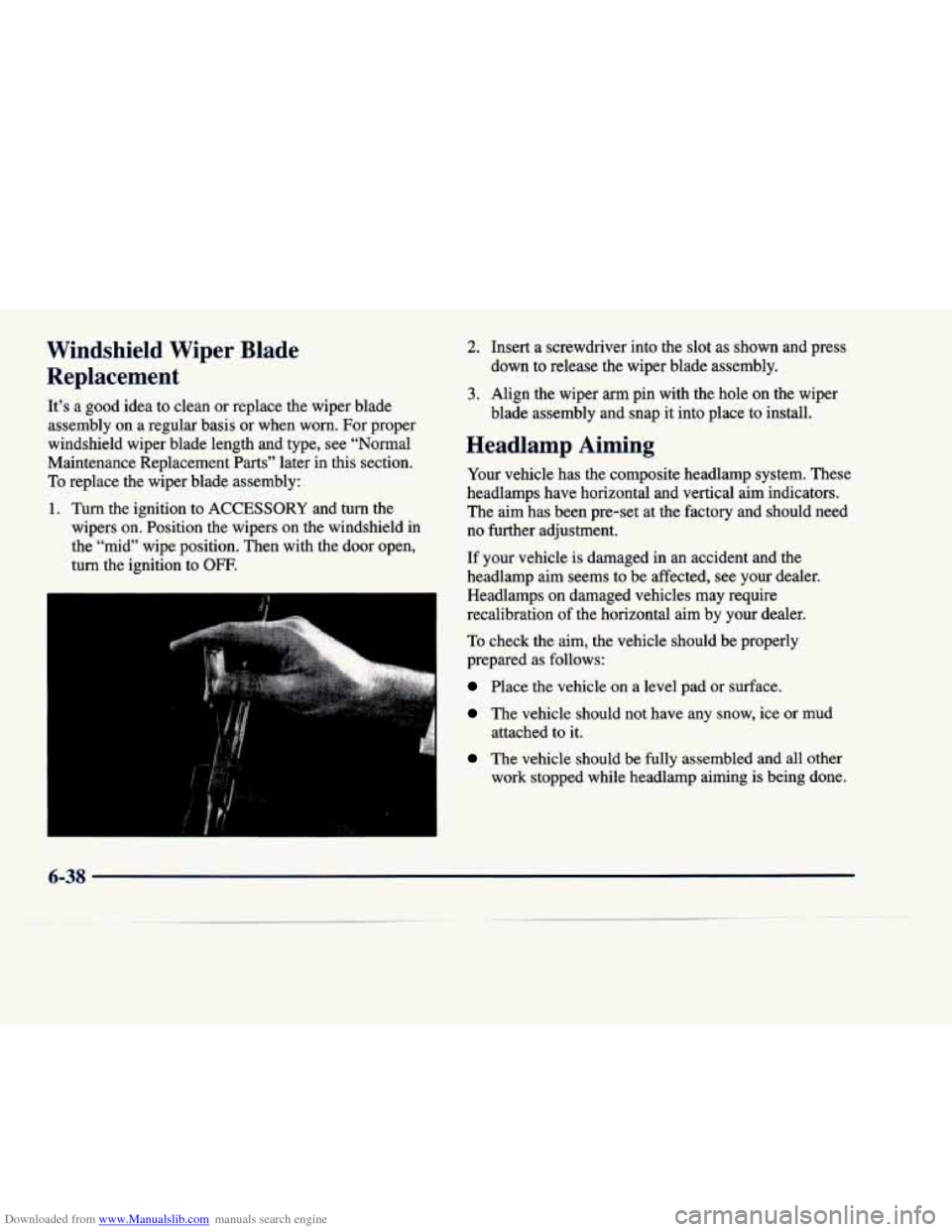
Downloaded from www.Manualslib.com manuals search engine Windshield Wiper Blade
Replacement
It’s a good iaea to clean or replace the wiper blade
assembly on a regular basis or when worn. For proper
windshield wiper blade length and type, see “Normal
Maintenance Replacement Parts” later in this section.
To replace the wiper blade assembly:
1. Turn the ignition to ACCESSORY and turn the
wipers on. Position the wipers on the windshield in
the
“mid” wipe position. Then with the door open,
turn the ignition to
OFF.
2. Insert a screwdriver into the slot as shown and press
down to release the wiper blade assembly.
3. Align the wiper arm pin with the hole on the wiper
blade assembly and snap it into place to install.
Headlamp Aiming
Your vehicle has the composite headlamp system. These
headlamps have horizontal and vertical aim indicators.
The
aim has been pre-set at the factory and should need
no further adjustment.
If your vehicle is damaged in an accident and the
headlamp aim seems to be affected, see your dealer.
Headlamps on damaged vehicles may require
recalibration of the horizontal aim by your dealer.
To check the aim, the vehicle should be properly
prepared as follows:
Place the vehicle on a level pad or surface.
The vehicle should not have any snow, ice or mud
The vehicle should be fully assembled and all other
work stopped while headlamp aiming is being done.
attached to it.
6-38
Page 327 of 386

Downloaded from www.Manualslib.com manuals search engine 2. Check the vertical headlamp aim first. Keep in mind
that your vehicle needs to be on a level surface. Turn
the vertical aiming screw until the bubble inside the
level is centered at
“0.”
3. After the vertical aim is correct, check the horizontal
aim for each headlamp and adjust as necessary. Turn
the horizontal aiming screw until the end of the
screw aligns with the
“0.”
correct after the horizontal aim adjustment. Adjust
as necessary.
4. Recheck the vertical aim to make sure it remains
6-40
Page 328 of 386
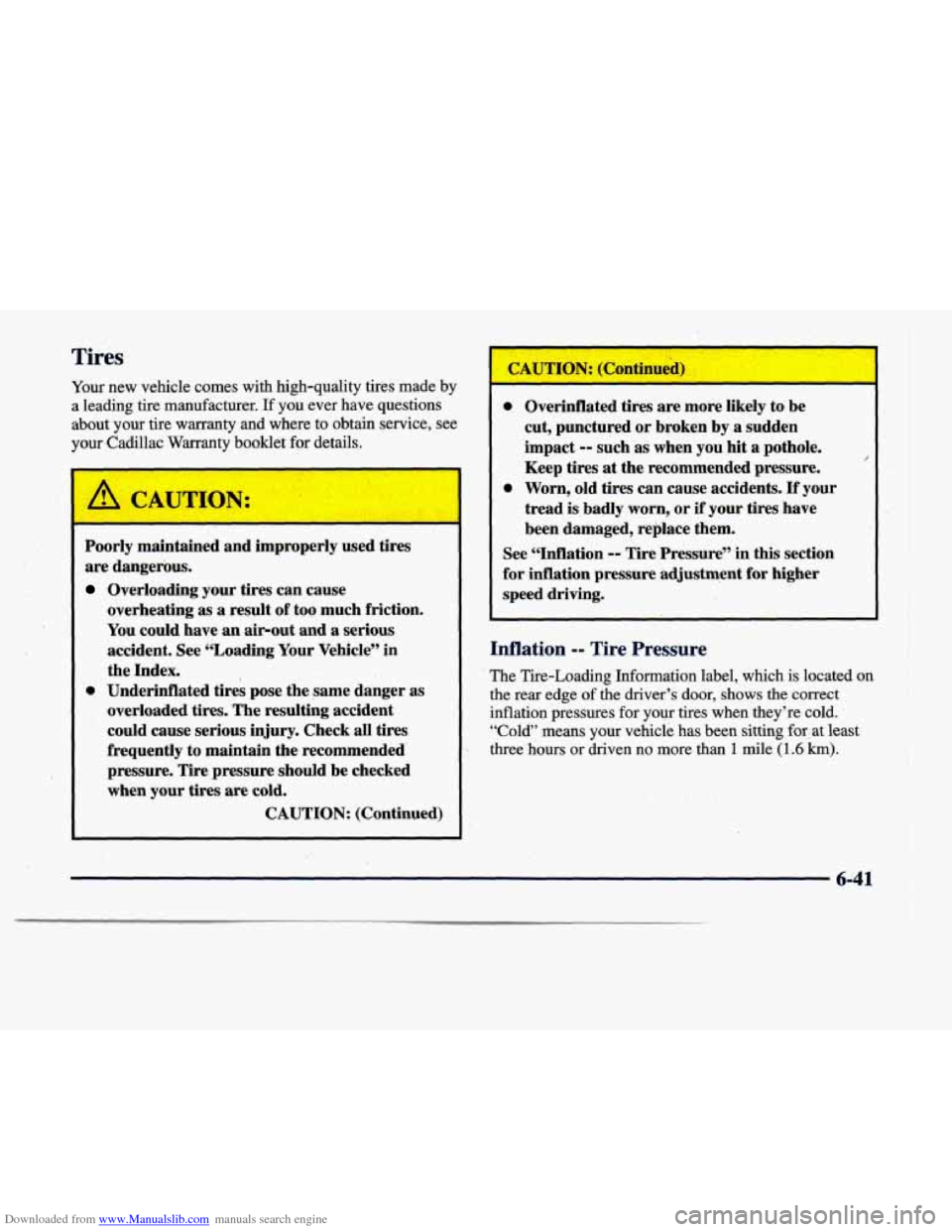
Downloaded from www.Manualslib.com manuals search engine Tires
Your ~ew vehicle comes with high-quality tires made by
a leading tire manufacturer. If you ever have questions
about your tire warranty and where ,to obtain service, see
your-Cadillac Warranty booklet for details.
I-
A CAUTION:
L
Poorly maintained and improperly used tires
are dangerous.
Overloading your tires can cause
overheating as
a result of too much friction.
You could have an air-out and a serious
accident. See “Loading Your Vehicle” in the Index.
‘0 Underinflated tires pose the same danger as
overloaded tires. The resultihg accident
could cause serious injury. Check all tires
frequently to maintain the recommended’
pressure. Tire pressure should be checked when
your tires are cold.
CAUTION: (Continued) CAUTION:
(Continued)
0 Overinflated tires are more likely to be
cut, punctured or broken by
a sudden
impact
-- such las when you hit a pothole.
Keep tires at the recommended pressure.
0 Worn, old tires can cause accidents. If your
tread is badly worn, or
if your tires have
been damaged, replace them.
See “Inflation
-- Tire Pressure’’ in this section
for .inflation pressure adjustment for higher
speed driving.
Inflation -- Tire Pressure
The Tire-Loading Information label, which is located on
the rear edge of the driver’s door, shows the correct
inflatiop pressures for your tires when they’re cold.
“Cold” means your vehicle has been sitting for, at least.
three’ hours or driven no more than
1 mile (1.6 km).
6-41
I -. ..
Page 329 of 386
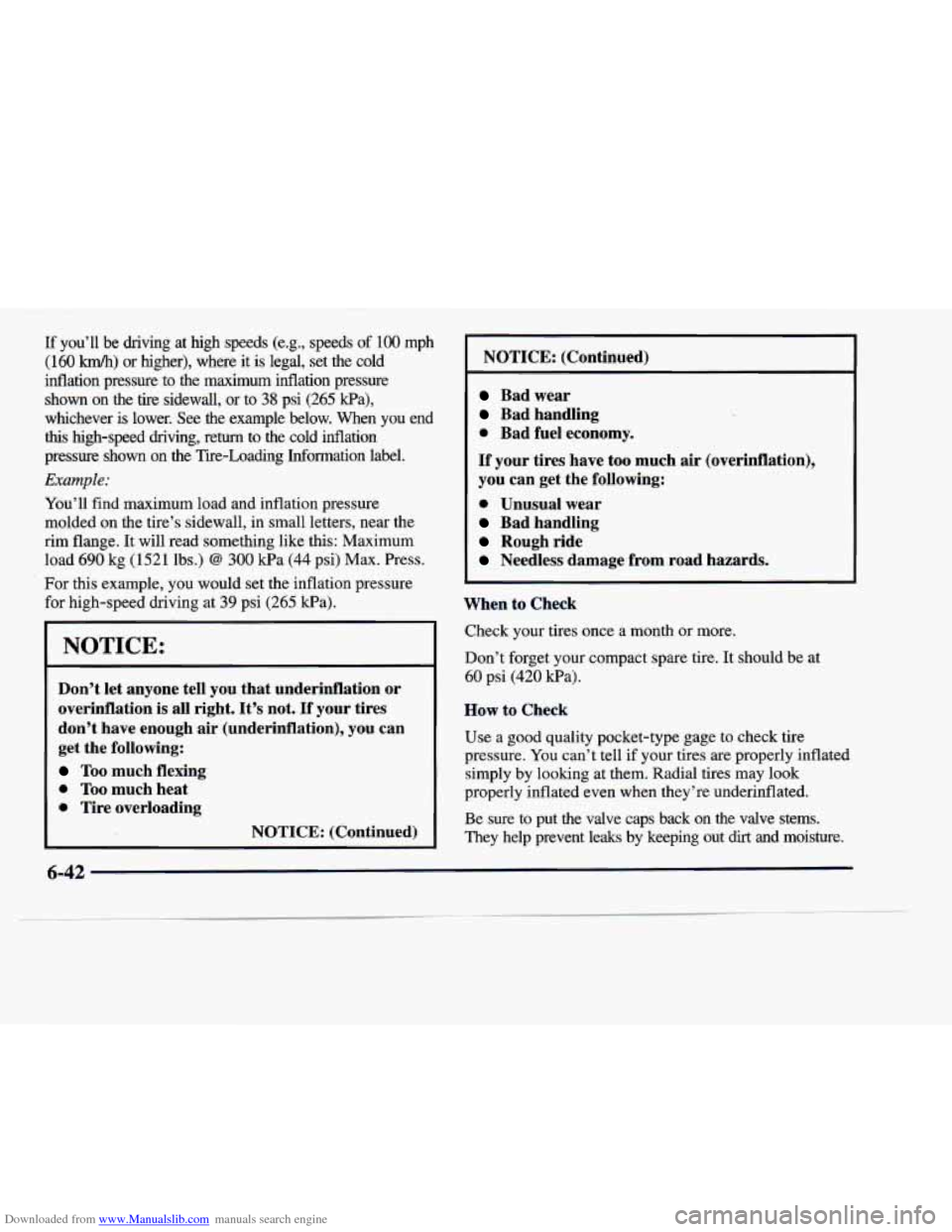
Downloaded from www.Manualslib.com manuals search engine - -
If you’ll be driving at high speeds (e.g., speeds of 100 mph
(160 km/h) or higher), where it is legal, set the cold
inflation pressure to the maximum inflation pressure shown on the
tire sidewall, or to 38 psi (265 kpa),
whichever is lower. See the example below. When you end
this high-speed driving, return to the cold inflation
pressure shown on the Tire-Loading Information label.
Example:
You’ll find maximum load and inflation pressure molded
on the tire’s sidewall, in small letters, near the
rim flange. It will read something like this: Maximum load 690
kg (1521 lbs.) @ 300 Wa (44 psi) Max. Press.
For this example,
you would set the inflation pressure
for high-speed driving at
39 psi (265 kPa).
NOTICE:
Don’t let anyone tell you that underinflation or
overinflation is all right.
It’s not. If your tires
don’t have enough air (underinflation), you can
get the following:
Too much flexing
0 Too much heat
0 Tire overloading
NOTICE: (Continued)
NOTICE: (Continued)
Bad wear
Bad handling
0 Bad fuel economy.
If your tires have too much air (overinflation),
you can get the following:
0 Unusual wear
Bad handling
Rough ride
Needless damage from road hazards.
When to Check
Check your tires once a month or more.
Don’t forget your compact spare tire. It should be at
60 psi (420 kPa).
How to Check
Use a good quality pocket-type gage to check tire
pressure.
You can’t tell if your tires are properly inflated
simply by looking at them. Radial tires may look
properly inflated even when they’re underinflated.
Be sure to put the valve caps back on the valve stems.
They help prevent leaks
by keeping out dirt and moisture.
6-42
Page 330 of 386
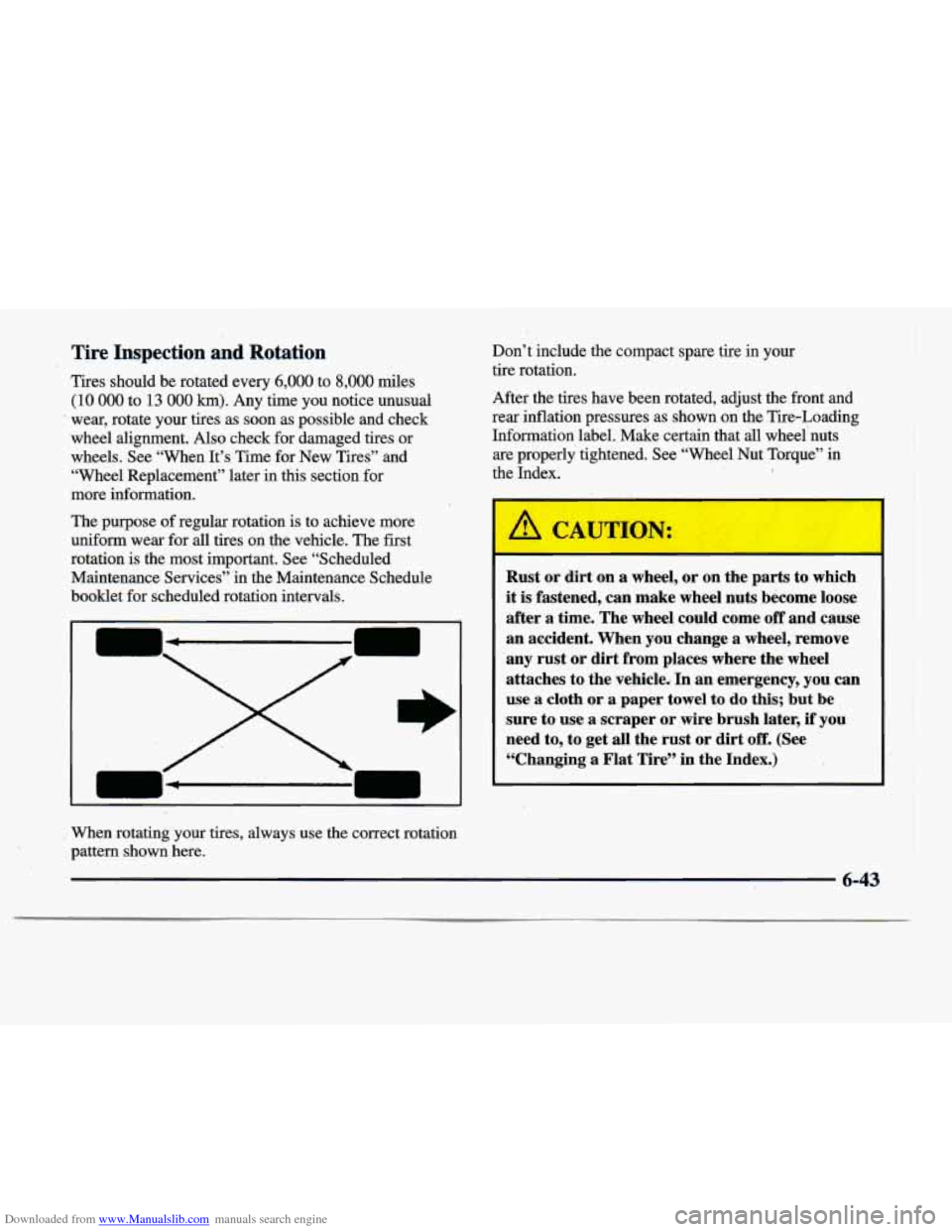
Downloaded from www.Manualslib.com manuals search engine Tire Inspection and Rotation
Tires should be rotated every 6,000 to 8,000 rriiles
(10 000 to 13 000 krn). Any time you notice unusual
. wear, rotate your tires as soon as possible and check
wheel alignment.
Also check for damaged tires or
wheels. See “When It’s Time for New Tires” and
“Wheel Replacement” later
in this section for
more information.
The purpose of regular rotation
is to achieve more
uniform wear for
all tires on the vehicle. The first
rotation
is the most important. See “Scheduled
Maintenance Services” in the Maintenance Schedule
booklet for scheduled rotation intervals.
When rotating your tires, always use the correct rotation
pattern shown here. Don’t include the compact spare tire
in your
tire rotation.
After the tires have been rotated, adjust the front and
rear inflation pressures as shown on the Tire-Loading
Information label. Make certain that
all wheel nuts
are properly tightened. See “Wheel Nut Torqoe” in
the Index.
Rust or dirt on a wheel, or on the parts to which
it is fastened, can make wheel nuts become loose
after a time. The wheel could come
off and cause
an accident. When you change
a wheel, remove
any rust
or dirt from places where the wheel
attaches to the vehicle.
In an emergency, you can
use
a cloth or a paper towel to do this; but be
sure to use a scraper or wire brush later,
if you
need to, to get all the rust or dirt
off. (See ’ .
“Changing a Flat Tire” in the Index.)
6-43